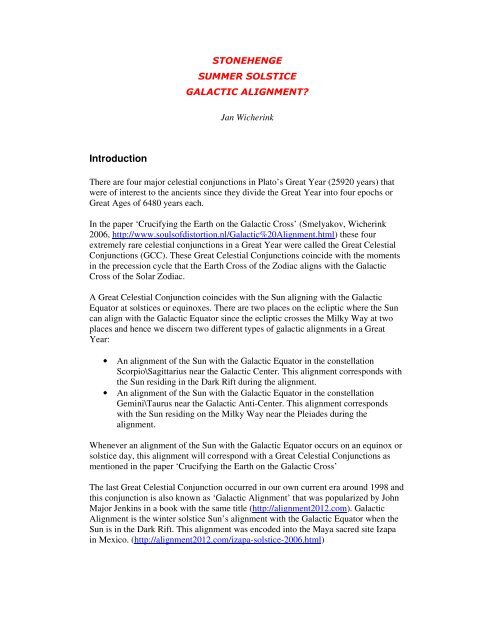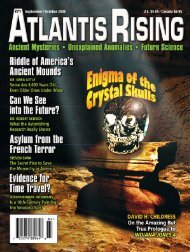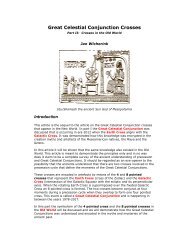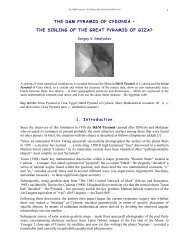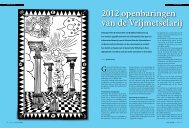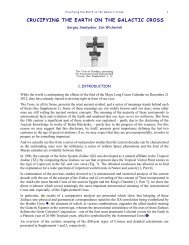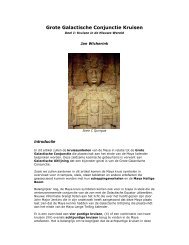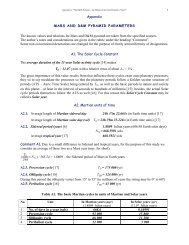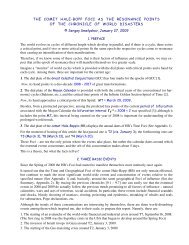Stonehenge Summer Solstice Galactic Alignment - Souls of Distortion
Stonehenge Summer Solstice Galactic Alignment - Souls of Distortion
Stonehenge Summer Solstice Galactic Alignment - Souls of Distortion
You also want an ePaper? Increase the reach of your titles
YUMPU automatically turns print PDFs into web optimized ePapers that Google loves.
STONEHENGE<br />
SUMMER SOLSTICE<br />
GALACTIC ALIGNMENT?<br />
Jan Wicherink<br />
Introduction<br />
There are four major celestial conjunctions in Plato’s Great Year (25920 years) that<br />
were <strong>of</strong> interest to the ancients since they divide the Great Year into four epochs or<br />
Great Ages <strong>of</strong> 6480 years each.<br />
In the paper ‘Crucifying the Earth on the <strong>Galactic</strong> Cross’ (Smelyakov, Wicherink<br />
2006, http://www.souls<strong>of</strong>distortion.nl/<strong>Galactic</strong>%20<strong>Alignment</strong>.html) these four<br />
extremely rare celestial conjunctions in a Great Year were called the Great Celestial<br />
Conjunctions (GCC). These Great Celestial Conjunctions coincide with the moments<br />
in the precession cycle that the Earth Cross <strong>of</strong> the Zodiac aligns with the <strong>Galactic</strong><br />
Cross <strong>of</strong> the Solar Zodiac.<br />
A Great Celestial Conjunction coincides with the Sun aligning with the <strong>Galactic</strong><br />
Equator at solstices or equinoxes. There are two places on the ecliptic where the Sun<br />
can align with the <strong>Galactic</strong> Equator since the ecliptic crosses the Milky Way at two<br />
places and hence we discern two different types <strong>of</strong> galactic alignments in a Great<br />
Year:<br />
• An alignment <strong>of</strong> the Sun with the <strong>Galactic</strong> Equator in the constellation<br />
Scorpio\Sagittarius near the <strong>Galactic</strong> Center. This alignment corresponds with<br />
the Sun residing in the Dark Rift during the alignment.<br />
• An alignment <strong>of</strong> the Sun with the <strong>Galactic</strong> Equator in the constellation<br />
Gemini\Taurus near the <strong>Galactic</strong> Anti-Center. This alignment corresponds<br />
with the Sun residing on the Milky Way near the Pleiades during the<br />
alignment.<br />
Whenever an alignment <strong>of</strong> the Sun with the <strong>Galactic</strong> Equator occurs on an equinox or<br />
solstice day, this alignment will correspond with a Great Celestial Conjunctions as<br />
mentioned in the paper ‘Crucifying the Earth on the <strong>Galactic</strong> Cross’<br />
The last Great Celestial Conjunction occurred in our own current era around 1998 and<br />
this conjunction is also known as ‘<strong>Galactic</strong> <strong>Alignment</strong>’ that was popularized by John<br />
Major Jenkins in a book with the same title (http://alignment2012.com). <strong>Galactic</strong><br />
<strong>Alignment</strong> is the winter solstice Sun’s alignment with the <strong>Galactic</strong> Equator when the<br />
Sun is in the Dark Rift. This alignment was encoded into the Maya sacred site Izapa<br />
in Mexico. (http://alignment2012.com/izapa-solstice-2006.html)
Picture 1) Winter solstice Sun (1998) in the Dark Rift <strong>of</strong> the Milky Way<br />
John Major Jenkins - <strong>Galactic</strong> <strong>Alignment</strong><br />
Since the conjunction <strong>of</strong> the Sun with the <strong>Galactic</strong> Equator happens twice a year, we<br />
also had a summer solstice <strong>Galactic</strong> <strong>Alignment</strong> happening around the last GCC in the<br />
year 1998. During this alignment the Sun was on the Milky Way near the <strong>Galactic</strong><br />
Anti-Center, which in turn is close to the Pleiades.<br />
Picture 2) <strong>Summer</strong> solstice Sun (1998) on the Milky Way<br />
Notice the Pleiades on the bottom right!
In this article we will reveal how <strong>Stonehenge</strong> may encode exactly this summer<br />
solstice alignment <strong>of</strong> the Sun with the <strong>Galactic</strong> Equator. It’s a summer solstice version<br />
<strong>of</strong> John Major Jenkins winter solstice <strong>Galactic</strong> <strong>Alignment</strong>.<br />
The Pleiades will become the key in unlocking the secrets <strong>of</strong> the summer solstice<br />
<strong>Galactic</strong> <strong>Alignment</strong> <strong>of</strong> <strong>Stonehenge</strong>. <strong>Stonehenge</strong> may not be the only ancient site that<br />
encodes the current summer solstice <strong>Galactic</strong> <strong>Alignment</strong>; we have every reason to<br />
suspect that there may be more.<br />
Picture 3) <strong>Stonehenge</strong> UK<br />
Wayne Herschel’s monumental work on the ancient star maps<br />
In 2003 Wayne Herschel published his monumental work ‘The Hidden Records’. This<br />
book is the culmination <strong>of</strong> years <strong>of</strong> research into many ancient sites around the world.<br />
His book presents the recovery <strong>of</strong> ancient star maps that were encoded on the land<br />
following the ancient Hermetic principle ‘as above, so below’. Herschel’s book shows<br />
that a pyramid building culture must have once thrived on this planet since hundredths<br />
<strong>of</strong> pyramids have already been discovered all over the globe and in the last decade<br />
alone ‘new’ pyramids have been unearthed in unexpected places such as in Bosnia-<br />
Herzegovina in Europe.<br />
Herschel discovered that all the stars along the Nile in Egypt actually mimic<br />
constellations along the Milky Way. For some reason the Egyptian star map seemed<br />
to put extra emphasis on the constellation Pleiades that corresponds with the pyramids<br />
at Abusir south <strong>of</strong> Giza along the Nile.<br />
Much to his surprise Herschel discovered more ancient sites around the world that had<br />
been using the Pleiades as a central theme. Among these sites were:<br />
• Tikal Guatemala<br />
• Angkor Cambodia
• <strong>Stonehenge</strong><br />
• Cydonia on Mars<br />
But the same recurring Pleiades theme was also discovered in:<br />
• Lascaux Halls <strong>of</strong> the Bulls cave in France<br />
• Sardinian cave paintings<br />
• Sumerian clay tablets<br />
• The Nineveh disc<br />
• Egyptian Dendera zodiac<br />
Herschel interpreted this recurring ‘Pleiades theme’ as a way shower to a certain star,<br />
a solar system with a G2 class star that could have an Earth like planet, the home<br />
planet <strong>of</strong> the extraterrestrials that he believes were the architects <strong>of</strong> all the ancient<br />
monuments. His conclusion was drawn after studying ancient artifacts and ancient<br />
texts that clearly are suggestive <strong>of</strong> an extraterrestrial presence in ancient times here on<br />
Earth.<br />
The author <strong>of</strong> this article does not object to such a view, however I do think that<br />
Herschel’s interpretation <strong>of</strong> the ‘Pleiades theme’ may be wrong in this sense that it is<br />
not likely to express a place in the sky, a ‘mystery’ star, the home <strong>of</strong> extraterrestrials<br />
that once settled on Earth as Herschel wants us to believe.<br />
Missing aspects <strong>of</strong> Herschel’s star map interpretation<br />
In interpreting the meaning <strong>of</strong> the Pleiades theme in the ancients sites that Herschel<br />
investigated, one important factor seem to have been overlooked and that’s the<br />
astronomical significance <strong>of</strong> these sites. Therefore Herschel’s ‘mystery’ star theory is<br />
most likely incorrect considering the following facts:<br />
• All the ancient sites dealing with the Pleiades star map were astronomical and<br />
astrological sites with equinox and solstice alignments that were not taken into<br />
consideration by Herschel when decoding the star maps.<br />
• The ‘mystery star in Egypt near Abusir corresponds to the temple <strong>of</strong> Ra. The<br />
consensus by Egyptologists is that Ra must be associated with the Sun in the<br />
Egyptians texts and not with some hypothetical G2 class star. In addition the<br />
alignment <strong>of</strong> the Sun Temple at Abusir is an anomaly in his star map theory, it<br />
does not point into the same direction the other ‘mystery‘ stars do in the rest <strong>of</strong><br />
his star maps.<br />
• When Herschel checked his astronomical s<strong>of</strong>tware for his ‘mystery’ star he<br />
couldn’t find a star close enough to match his ‘mystery’ star. Using new<br />
s<strong>of</strong>tware and rewinding the clock back 17.500 years he finally succeeded and<br />
was able to make a match. If the ‘mystery’ star isn’t a star at all as we are<br />
suspecting, it comes as no surprise that Herschel wasn’t able to locate this star<br />
in the first place.
Bringing the astronomical significance <strong>of</strong> the ancient sites to the forefront will<br />
reveal a new and very compelling significance <strong>of</strong> this ‘Pleiades theme’ in these<br />
ancient sites that were tracking the summer solstices!<br />
A new light on Herschel’s mystery star<br />
It’s my hypothesis that Herschel’s ‘mystery’ star near the Pleiades in fact represents<br />
a midpoint between the Pleiades and the place where ‘the Sun is on the Milky Way’.<br />
The ‘mystery’ star therefore represents a way shower to a ‘precession anchor’ that<br />
can be used to determine a special moment in the Great Year as it connects the<br />
Pleiades with this ’precession anchor’.<br />
The ‘mystery‘ star in fact is the Sun itself! Some <strong>of</strong> the ancient sites that Herschel<br />
mentions are built close to a river. Its my assumption that the river mimics the great<br />
river in the sky, the Milky Way. The summer solstice observatories such as<br />
<strong>Stonehenge</strong> were built close to the river to represent the ‘Sun on the Milky Way’. If<br />
the summer solstice observatory had been built in it’s correct position, it would have<br />
been built into the river (Milky Way) itself since this is the place where the Sun<br />
resides at <strong>Galactic</strong> <strong>Alignment</strong>. So there are obvious reasons as to why the ‘mystery<br />
star’ (the Sun) was built on the land and not in the river. The position <strong>of</strong> the ‘mystery’<br />
star (monument) on the land that aligns the Pleiades (monument) with the Milky Way<br />
(river) is in fact hinting at:<br />
The Sun on the Milky Way at the current summer solstice that<br />
coincides with the last Great Celestial Conjunction!<br />
The Sun on the ecliptic aligns with the Milky Way in the constellation Taurus where<br />
the Pleiades are. This may explain why the Egyptians worshiped the celestial Bull and<br />
why so many other cultures around the world venerated the Pleiades.<br />
The picture below is a view <strong>of</strong> the skies on the summer solstice sunrise around the last<br />
Great Celestial Conjunction (1998).
Picture 4) Sunrise at summer solstice 1998<br />
At summer solstice (June 21) <strong>of</strong> 2012, the Sun will be residing on the Milky Way near<br />
Taurus where the Pleiades are; it’s a summer solstice <strong>Galactic</strong> <strong>Alignment</strong> and the<br />
reverse situation <strong>of</strong> the better know winter solstice <strong>Galactic</strong> <strong>Alignment</strong> occurring six<br />
months later. Now let’s compare it with Herschel’s star map <strong>of</strong> the Pleiades:<br />
<strong>Summer</strong> <strong>Solstice</strong> Pleiades-Sun alignment<br />
close up<br />
Herschel’s star map<br />
Picture 5) Comparison between summer solstice 1998 Pleiades-Sun alignment and<br />
Herschel’s star map (http://www.thehiddenrecords.com/gods.htm)<br />
Notice in picture 5 how the Pleiades on the left are pointing towards the rising Sun on<br />
the summer solstice <strong>of</strong> 1998 while the picture on the right is showing Herschel’s star
map, it’s a recurring star map theme that has not only been found in Egypt but in other<br />
places around the world as well such as at <strong>Stonehenge</strong> and the Maya temple site Tikal<br />
in Guatemala.<br />
Mystery star and position <strong>of</strong> the Sun on the ecliptic<br />
On Herschel’s website we find pro<strong>of</strong> for the hypothesis <strong>of</strong> this article that the so<br />
called ‘mystery’ star in Herschel’s star maps which he thinks refers to a star near the<br />
Pleiades, is in fact denoting the position <strong>of</strong> the Sun on the ecliptic.<br />
On Herschel’s website the exact position <strong>of</strong> the Sun on the ecliptic is explained as<br />
follows: “between the bulls horns in Taurus when direction matches ancient sites”<br />
(See text bottom right in the image http://www.thehiddenrecords.com/gods.htm)<br />
So the location where the ‘mystery’ star is pointing too is the place where:<br />
THE SUN IS ON THE MILKY WAY AT SUMMER SOLSTICE 1998!<br />
The summer solstice Sun <strong>of</strong> 1998 will be in between the horns <strong>of</strong> Taurus when the<br />
Sun is on the Milky Way (See picture 7)!<br />
Picture 7) <strong>Summer</strong> solstice Sun 1998, the Sun is in between the Bull’s horns (Taurus)<br />
Herschel’s own website provides us with the arguments that our thesis may be correct<br />
and that the ‘mystery star’ in Herschel’s star maps is NOT a star near the Pleiades at<br />
all, but in fact is a way shower to the Sun on the ecliptic in between the horns <strong>of</strong><br />
Taurus! This position is where the Sun is on the ecliptic at the summer solstice <strong>of</strong><br />
1998 at the last Great Celestial Conjunction!
Pleiades Template<br />
Picture 8) Pleiades template<br />
To further test and pro<strong>of</strong> the hypothesis that the Pleiades in Herschel’s star maps may<br />
be pointing towards the 1998 solstice sun on the Milky Way a template <strong>of</strong> the<br />
Pleiades was created using the free open source astronomy s<strong>of</strong>tware Stellarium<br />
(http://www.stellarium.org/). Stellarium presents a realistic 3D representation <strong>of</strong> the<br />
sky similar to what we see with a naked eye observation <strong>of</strong> the stars. Stellarium will<br />
allow us to test out thesis.<br />
The template (picture 8) is created from a screenshot <strong>of</strong> Stellarium at the moment <strong>of</strong><br />
summer solstice 1998. The green line in this template is exactly aligning the stars<br />
Alcyone and Pleione with the 1998 summer solstice sun on the Milky Way. The<br />
orange line is a base line <strong>of</strong> the Pleiades constellation connecting the stars Taygeta,<br />
Maia and Alcyone <strong>of</strong> the Pleiades constellation with the stars HP 17832 and HP<br />
17900.<br />
This template will be tested on <strong>Stonehenge</strong> to see if the angle between the Pleiades<br />
and the solstice sun on the Milky Way has any significance with respect to<br />
<strong>Stonehenge</strong>.
<strong>Stonehenge</strong><br />
It is an established fact that <strong>Stonehenge</strong> was an astronomical observatory for both<br />
solar and lunar observations. One <strong>of</strong> its functions was the determination <strong>of</strong> the<br />
summer solstice date using the summer solstice sunrise. At the 21 st <strong>of</strong> June the rising<br />
sun in the North East shines its light in between the Heel Stone onto the Alter Stone at<br />
the center <strong>of</strong> the Trilithons or horseshoe <strong>of</strong> <strong>Stonehenge</strong>.<br />
Picture 9) <strong>Stonehenge</strong> summer solstice Sun alignment<br />
South West <strong>of</strong> <strong>Stonehenge</strong> we find the Winterbourne Stoke Barrows. Herschel<br />
claimed that the Winterbourne Stoke Barrows at <strong>Stonehenge</strong> actually represented a<br />
star map <strong>of</strong> the Pleiades and indeed these barrows seem to have the shape <strong>of</strong> this<br />
constellation. The Winterbourne Barrows as the Pleiades are pointing the way to<br />
<strong>Stonehenge</strong> according to Herschel.<br />
Picture 10) Winterbourne Stoke barrows
Now let’s superimpose our Pleiades template on the Winterbourne Stoke barrows and<br />
see if we can make a match first. To this end we align the stars on the orange base line<br />
in our template with the corresponding barrows at <strong>Stonehenge</strong>.<br />
Picture 11) Winterbourne Stoke barrows at <strong>Stonehenge</strong> (Google Earth)<br />
superimposed with the Pleiades template<br />
It’s quit obvious from the picture above that the barrows do not perfectly fit the stars<br />
<strong>of</strong> the Pleiades. Although the stars <strong>of</strong> the Pleiades constellation take on the same<br />
contours <strong>of</strong> the barrows, the geometrical pattern <strong>of</strong> the constellation itself is somewhat<br />
distorted since it is stretched along the orange base line. Surly the ratios between our<br />
template and the actual ground plan <strong>of</strong> the Pleiades do not match. Over long periods<br />
<strong>of</strong> time stars drift and this may very well explain why the barrows don’t match up<br />
perfectly with the actual constellation <strong>of</strong> the Pleiades any longer thousands <strong>of</strong> years<br />
later. However the barrows that are running in a straight line from South West to<br />
North East will allow for the mapping and alignment <strong>of</strong> the Pleiades star map<br />
template onto the Winterbourne Stoke barrows.<br />
If our hypothesis is correct and the orange base line <strong>of</strong> the Pleiades is aligned with the<br />
barrows, the green line should be pointing towards <strong>Stonehenge</strong>! So let’s zoom out and<br />
see what we got:
Picture 12) <strong>Stonehenge</strong> pointing the way to the Avon River (Milky Way)<br />
The green line <strong>of</strong> our template is running straight through<br />
<strong>Stonehenge</strong>!!!<br />
The green line runs through <strong>Stonehenge</strong> and eventually ends up intersecting the Avon<br />
river. The intersection is the place where the ‘Sun is on the Milky Way’.<br />
Let’s double check our thesis in reverse order. First we take a picture <strong>of</strong> the skies at<br />
summer solstice 1998 when the Sun is on the Milky Way with the aid <strong>of</strong> the<br />
Stellarium s<strong>of</strong>tware. Next we superimposed that picture onto <strong>Stonehenge</strong> making sure<br />
the Pleiades are superimposed on the Winterbourne Stoke barrows and the Sun is<br />
residing on the Avon river like this:
Picture 13) <strong>Summer</strong> <strong>Solstice</strong> 1998 superimposed on <strong>Stonehenge</strong>.<br />
(white line represents the summer solstice sunrise to which <strong>Stonehenge</strong> is aligned)<br />
If we now zoom in on the Winterbourne Stoke barrows we find the same result:<br />
Picture 14) Close up <strong>of</strong> the Winterbourne Stoke barrows alignment.
I think it’s safe to say that the coincidence <strong>of</strong> the near perfect alignment <strong>of</strong> the<br />
Winterbourne Stoke Barrows with <strong>Stonehenge</strong>, are beyond chance.<br />
Most likely <strong>Stonehenge</strong> represents the Sun itself. Since it could not be built into the<br />
river it was built on the land as a midpoint between the Winterbourne Stoke barrows<br />
and the Avon river. <strong>Stonehenge</strong> now became a way shower to the Sun and its purpose<br />
was to connect the Pleiades with the summer solstice Sun on the Milky Way (green<br />
line in picture 13).<br />
Additional pro<strong>of</strong><br />
At summer solstice the Sun at <strong>Stonehenge</strong> rises at 50º azimuth in the North East while<br />
the Pleiades can be found at 75º azimuth. This means that at summer solstice sunrise<br />
the Pleiades can be viewed from <strong>Stonehenge</strong> right above the Avon river at the<br />
location where a line drawn from the Winterbourne Stoke barrows through<br />
<strong>Stonehenge</strong> intersects the Avon river. This location <strong>of</strong> course corresponds with the<br />
‘Sun on the Milky Way’ in our thesis. In other words:<br />
At summer solstice sunrise the Winterbourne Stoke barrows,<br />
<strong>Stonehenge</strong> and the Pleiades align!<br />
Picture 15) <strong>Stonehenge</strong> links the Winterbourne Stoke barrows with the Pleiades.<br />
This fact shows that <strong>Stonehenge</strong> links the Winterbourne Stoke barrows with the<br />
Pleiades at summer solstice sunrise. The Pleiades are mirrored on the ground as the<br />
Winterbourne Stoke barrows with <strong>Stonehenge</strong> as the focal point <strong>of</strong> this mirror image.<br />
So let’s recap the facts:
• In order for the Winterbourne Stoke barrows to mirror the Pleiades at summer<br />
solstice sunrise, they were placed at 259º azimuth South West <strong>of</strong> <strong>Stonehenge</strong><br />
(See picture 15).<br />
• Next the orientation <strong>of</strong> the Winterbourne Stoke barrows on that location where<br />
created such that they would represent the Pleiades at a summer solstice<br />
galactic alignment (1998) when the Sun was on the Milky Way. This meant<br />
that the barrows would have to be aligned such that Alcyone and Pleione were<br />
aligned with <strong>Stonehenge</strong>, since this alignment was showing the way to the Sun<br />
on the Milky Way (see the green line in our template in picture 8).<br />
Considering the fact that <strong>Stonehenge</strong> is also a summer solstice sunrise observatory the<br />
message <strong>of</strong> <strong>Stonehenge</strong> now becomes very clear:<br />
<strong>Stonehenge</strong> is telling us that the Pleiades are pointing the way to the<br />
Sun on the Milky Way at summer solstice; in other words <strong>Stonehenge</strong><br />
encodes a summer solstice <strong>Galactic</strong> <strong>Alignment</strong>!<br />
Woodhenge<br />
Just North East <strong>of</strong> <strong>Stonehenge</strong> we find Woodhenge. Woodhenge is the wooden<br />
‘counterpart’ and precursor <strong>of</strong> <strong>Stonehenge</strong>. Woodhenge consists <strong>of</strong> concentric<br />
elliptical rings <strong>of</strong> wooden poles. Both the entrance <strong>of</strong> Woodhenge and the long axis <strong>of</strong><br />
the ellipses are oriented to the summer solstice sunrise making Woodhenge another<br />
summer solstice observatory.<br />
Picture 15) Woodhenge aerial photo
Recent excavations in 2006 <strong>of</strong> both Woodhenge and the Durrington Walls made<br />
archeologist believe that Woodhenge and <strong>Stonehenge</strong> were both part <strong>of</strong> one and the<br />
same ‘religious’ site. An avenue that connects Woodhenge with <strong>Stonehenge</strong> indicates<br />
that both sites were connected.<br />
If we take a look at picture 16 we see that Woodhenge is not only close to the river<br />
but also the so called ‘Cursus’, a path that archeologists believe represents an ancient<br />
race track, is running parallel with the ecliptic. In addition the ‘Cursus’ is running<br />
through Woodhenge!<br />
Picture 16) Cursus running through Woodhenges<br />
If the ‘Cursus’ was meant to represent the ecliptic and Woodhenge the Sun, the<br />
Woodhenge site would represent the place where the ecliptic (Cursus) and the Milky<br />
Way (Avon river) intersect. In other words:<br />
Woodhenge could represent the ‘Sun on the Milky Way’ at a summer<br />
solstice galactic alignment<br />
Conclusions<br />
Given Herschel’s multiple Pleiades themes found around the world which he has<br />
interpreted as a ‘mystery’ star, we <strong>of</strong>fer a new interpretation <strong>of</strong> Herschel’s ‘mystery’<br />
star in this article. An interpretation that takes into account the astronomical<br />
significance <strong>of</strong> the sites in question something that Herschel did not take into<br />
consideration. We took <strong>Stonehenge</strong> as an example and demonstrated that our thesis<br />
apparently works for <strong>Stonehenge</strong>. It could mean that the ancients have left us clues<br />
about our current:<br />
Great Celestial Conjunction or summer solstice <strong>Galactic</strong> <strong>Alignment</strong>, the<br />
astronomical event that hails a New Age.
References<br />
http://www.thehiddenrecords.com/<br />
http://alignment2012.com/<br />
http://www.souls<strong>of</strong>distortion.nl/Giza.html<br />
http://www.astrotheos.narod.ru/


